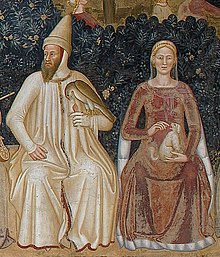Antonia Visconti
Antonia Visconti (* after 1350, presumably in Milan ; † March 26, 1405 in the Old Palace in Stuttgart ) was Countess of Württemberg .

Life
Antonia Visconti was one of the daughters of 17 children of Bernabò Visconti , Lord of Milan . Antonia Visconti was one of the 10 children born in wedlock from his marriage to Beatrice della Scala of the Scaliger family , the lords of Verona .
Antonia was initially King Friedrich III. promised by Sicily as a wife, but Friedrich III died. 1377, in front of the agreed supplement, whereupon Bernabo Visconti on July 1, 1380 a marriage speech for Antonia with Eberhard III. of Württemberg closed.
The brideprice the Duchess Antonia amounted to 70,000 guilders as dowry to a tremendously high for that time sum, along with other jewels and brideprice that Antonia Urach brought. On October 27, 1380 , the wedding of Antonia Visconti and Count Eberhard III took place in Urach , with festivities lasting many days.
Palm Hall in Urach Castle
Council meeting Eberhard der Milde
Coat of arms of the ancestors of Eberhard I , including the coat of arms of the Visconti
Eberhard III. signed Antonia Bietigheim and Brackenheim as Wittum . As Countess of Württemberg, Antonia promoted the spread of music, literature and all the fine arts in Stuttgart, Bietigheim and all of Württemberg. The fraw von Mailant garten ( the Duchess of Milan's garden ), which was built south of the Old Palace in Stuttgart, was designed, laid out and designed according to the ideas of Countess Antonia.
From the marriage of Eberhard III. Several children were born with Antonia Visconti, of which only the later Count Eberhard IV reached adulthood.
Of Antonia's siblings, Duchess Taddea became the wife of Duke Stephan III. of Bavaria, Duchess Maddalena became the wife of Duke Friedrich of Bavaria, Duchess Elisabetta the wife of Duke Ernst of Bavaria and Duchess Viridis became the wife of Duke Leopold III. from Austria. The sisters also brought an equally precious trousseau over the Brenner Pass north to their new home, as did Antonia.
Antonia Visconti, Countess of Württemberg, was buried in the choir of the Stuttgart collegiate church. After her death, Eberhard III married. with Elisabeth of Nuremberg .
The Villa Visconti, built in 2002 in the old town of Bietigheim, still reminds of Antonia Visconti, the Countess of Württemberg.
literature
- Julia Lauxmann: Antonia Visconti, Countess in Württemberg. In: Peter Rückert (Ed.): Antonia Visconti († 1405) - a treasure in the Württemberg house. Accompanying book and catalog for the exhibition of the Baden-Württemberg State Archive - Main State Archive Stuttgart. Main State Archives, Stuttgart 2005, ISBN 3-00-015015-3 , pp. 52–55.
- Matthias Miller: Antonia Visconti. In: Sönke Lorenz , Dieter Mertens , Volker Press (eds.): Das Haus Württemberg. A biographical lexicon. Kohlhammer, Stuttgart 1997, ISBN 3-17-013605-4 , p. 42f.
- Gerhard Raff : Hie good Wirtemberg all the way. Volume 1: The House of Württemberg from Count Ulrich the Founder to Duke Ludwig. 6th edition. Landhege, Schwaigern 2014, ISBN 978-3-943066-34-0 , pp. 213-221.
- Peter Rückert, Sönke Lorenz (ed.): The Visconti and the German Southwest. Cultural transfer in the late Middle Ages (= Tübingen building blocks for regional history. Volume 11). Thorbecke, Ostfildern 2008, ISBN 978-3-7995-5511-1 .
Web links
- Antonia Visconti - A treasure in the Württemberg home (Landesarchiv Baden-Württemberg)
- Barbara Tuchman in: http://www.wfelix.org/tuchman.html
Footnotes
- ↑ The exact date is not certain: The inventory consists of 4 sheets of a list of those lands and income of the Wirtemberg house on which the bride was insured; The notary Johannes Falconus from Bergamo attests to this register, in the presence of the mentioned Italian noblemen (Dr. Faustinus Lantana and Paganinus de Blassano) in the hall of the castle at Urach on October 27th 1380. That was probably the wedding. In: Paul Friedrich von Stälin : History of Württemberg . Volume 3. 1856, p. 356, quoted from Raff p. 219.
| personal data | |
|---|---|
| SURNAME | Visconti, Antonia |
| BRIEF DESCRIPTION | Countess of Württemberg |
| DATE OF BIRTH | after 1350 |
| PLACE OF BIRTH | Milan |
| DATE OF DEATH | March 26, 1405 |
| Place of death | Old Castle (Stuttgart) |


